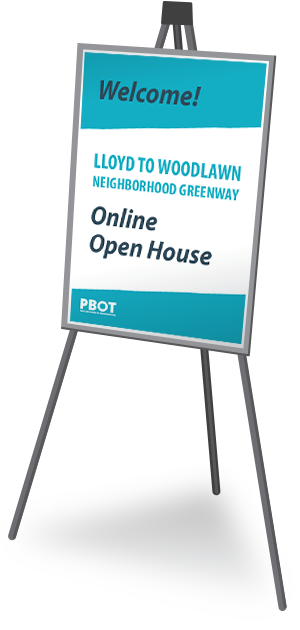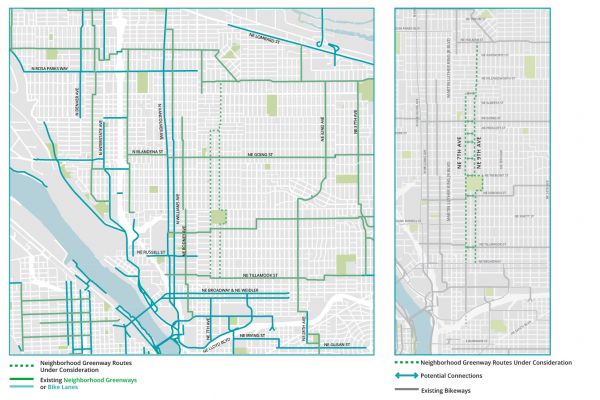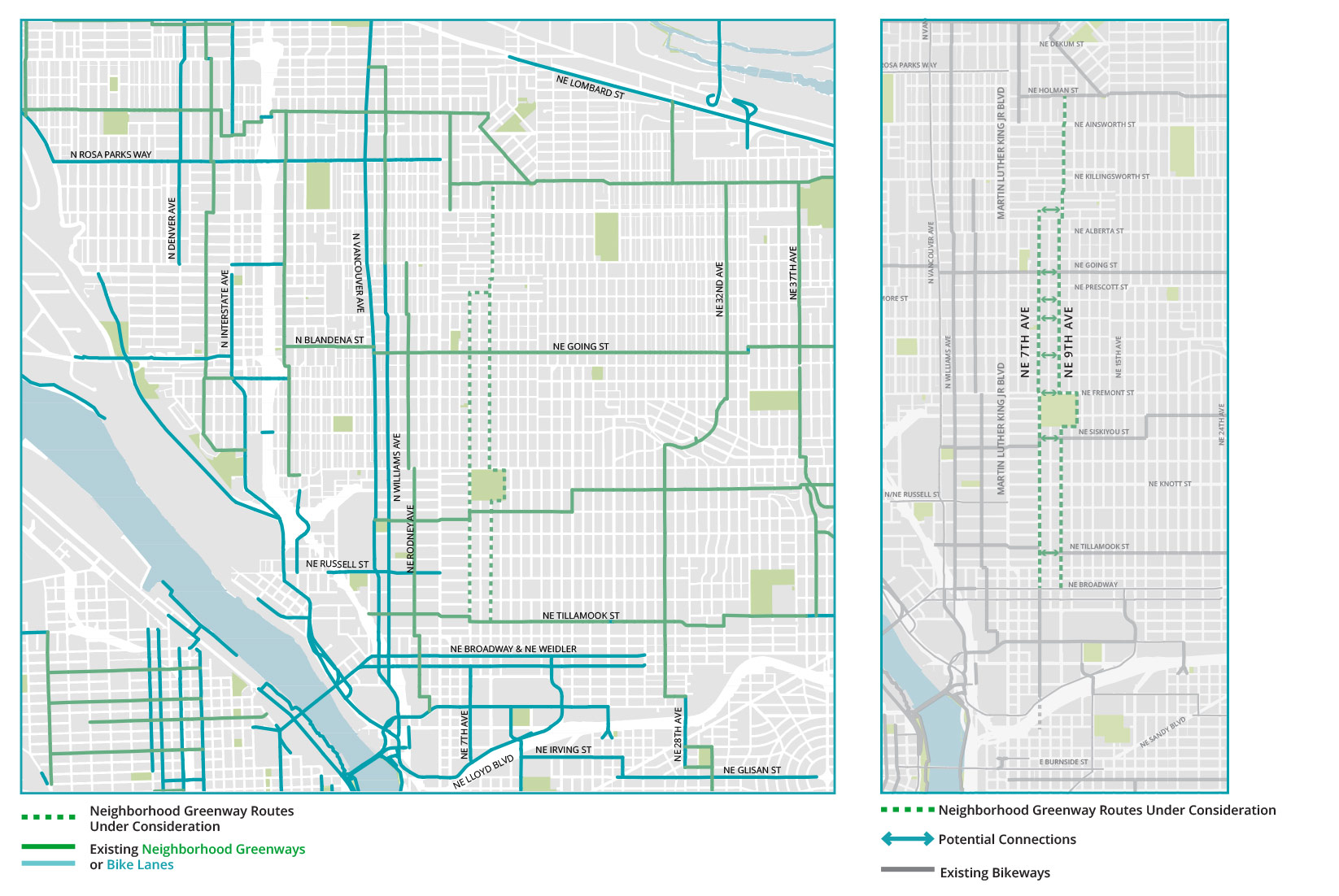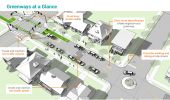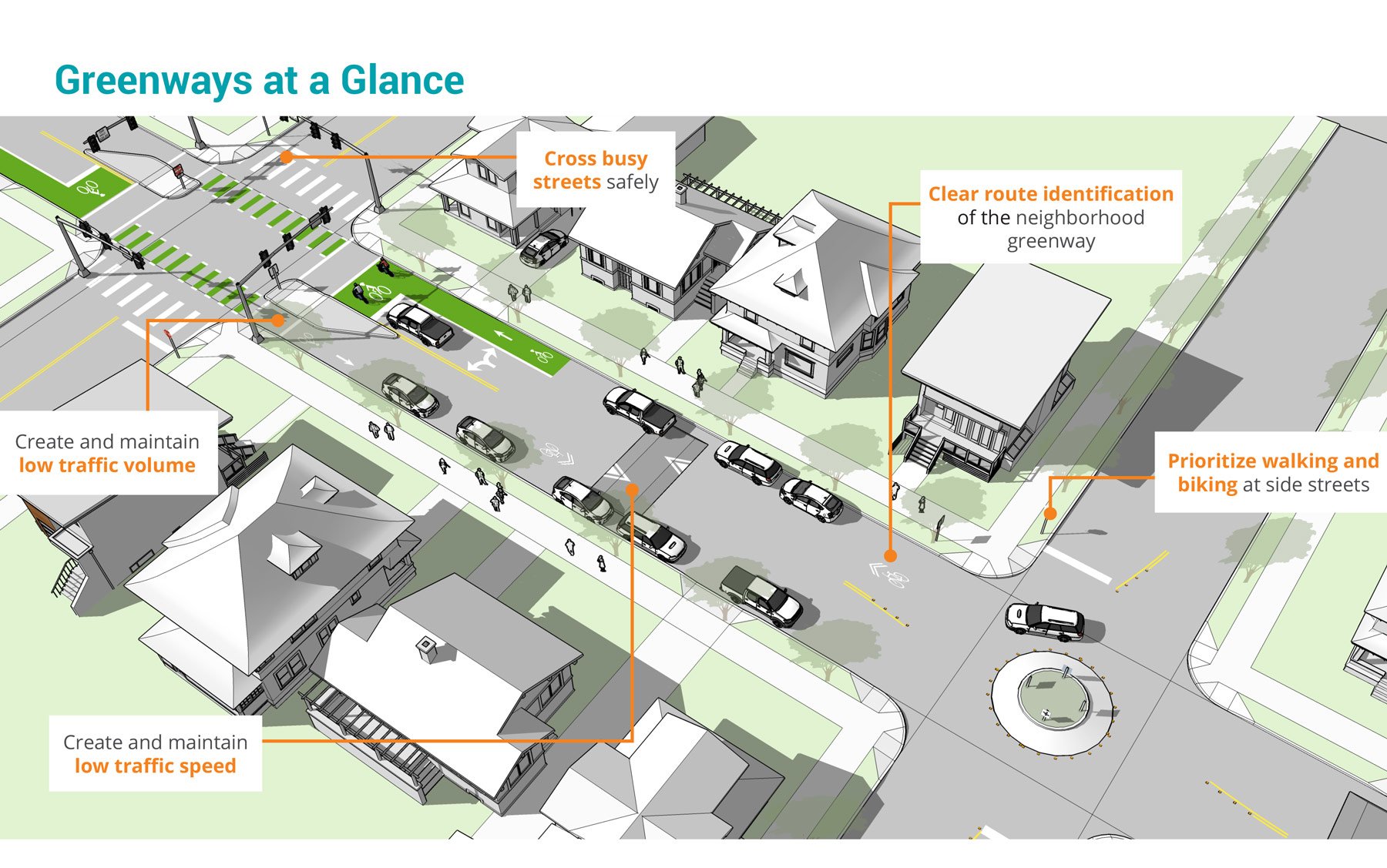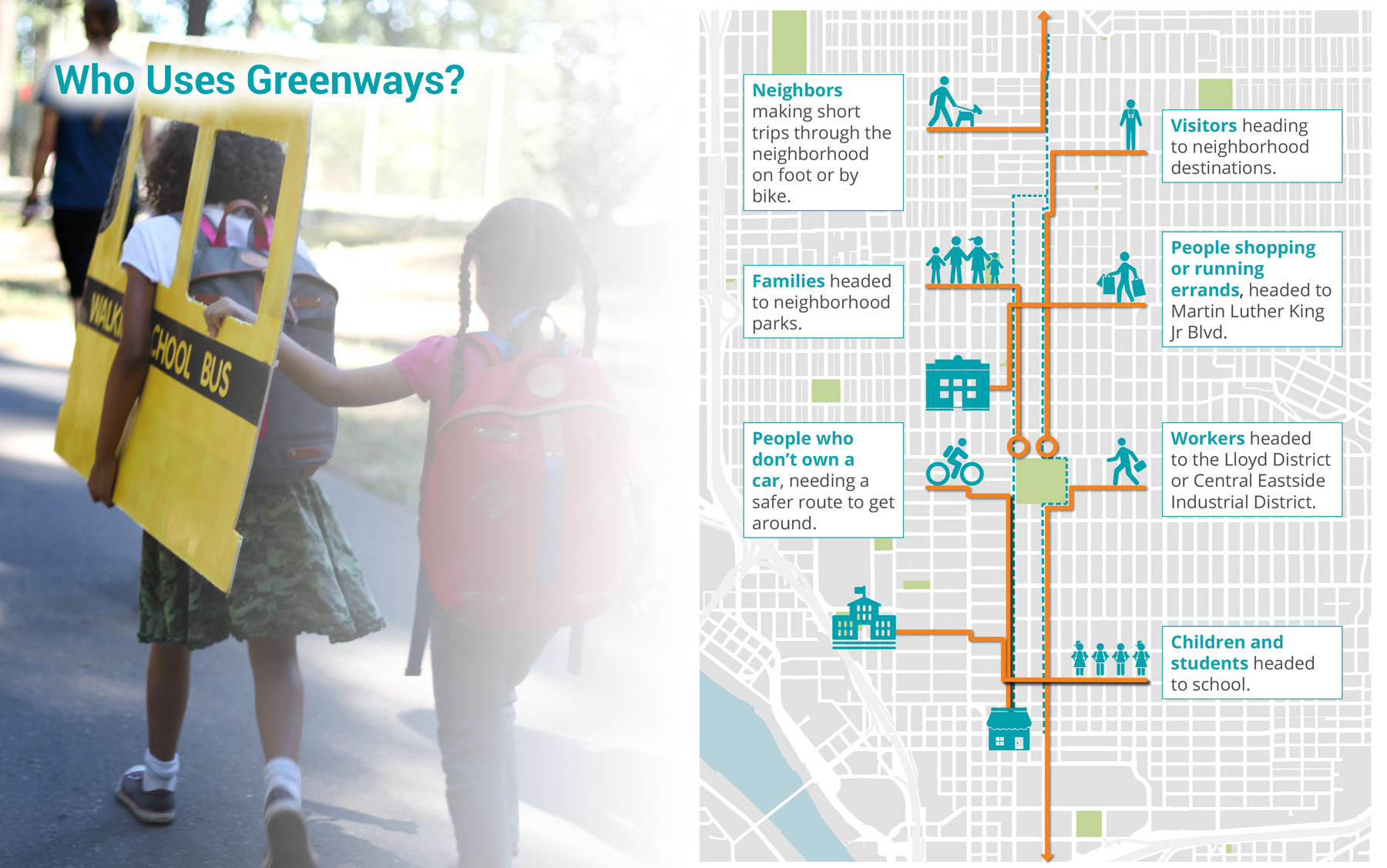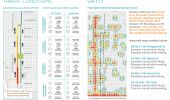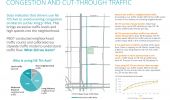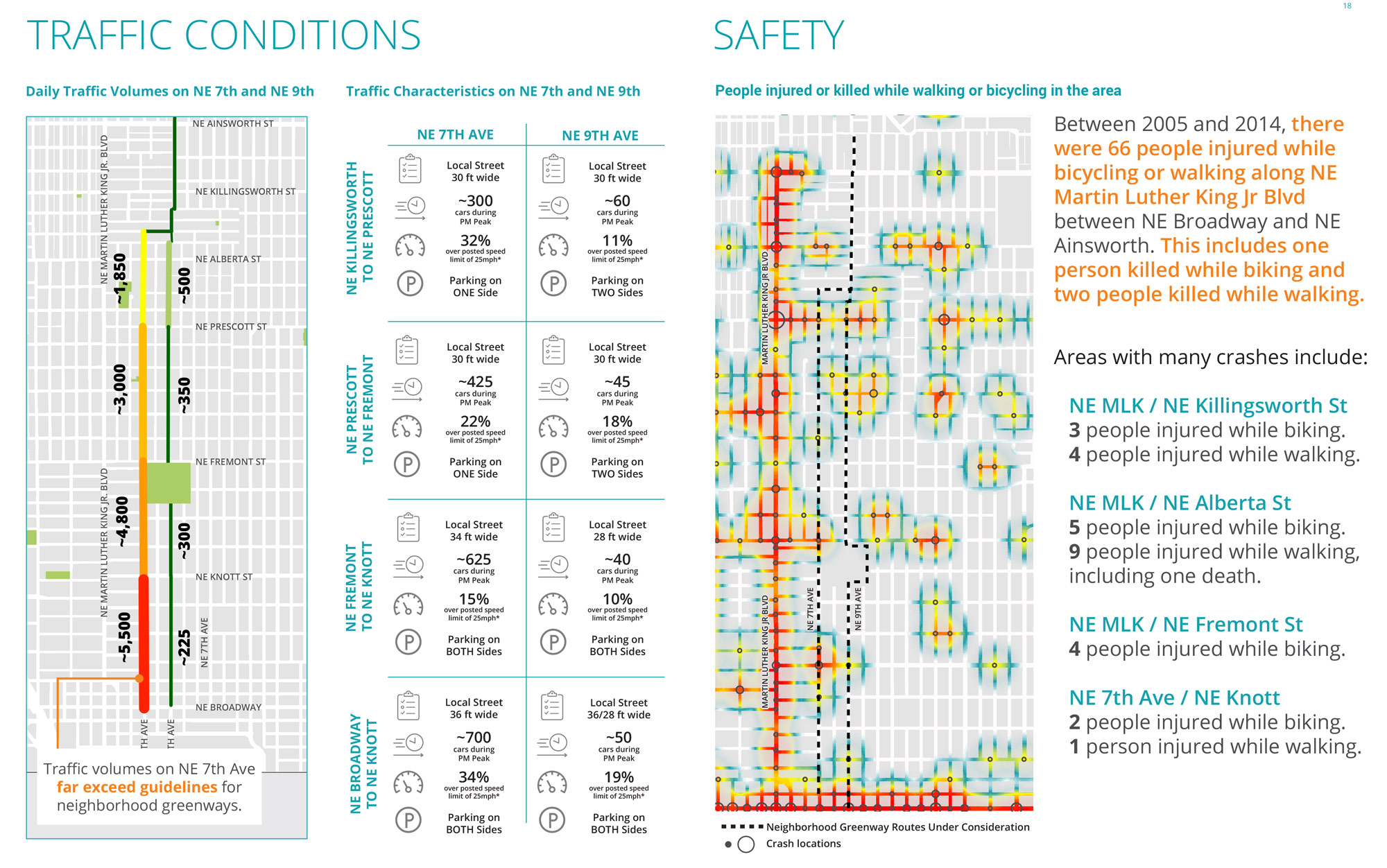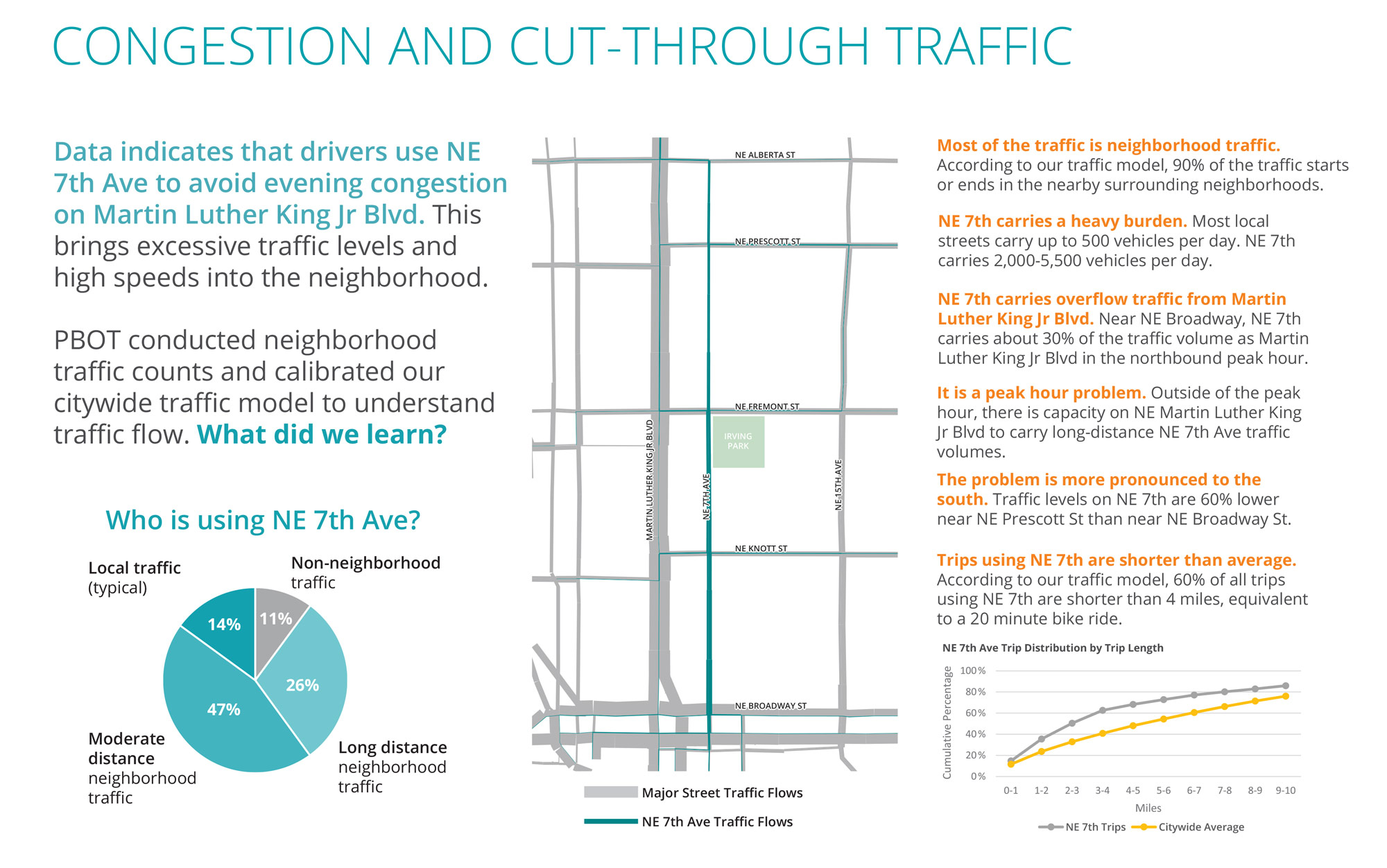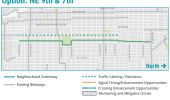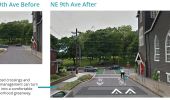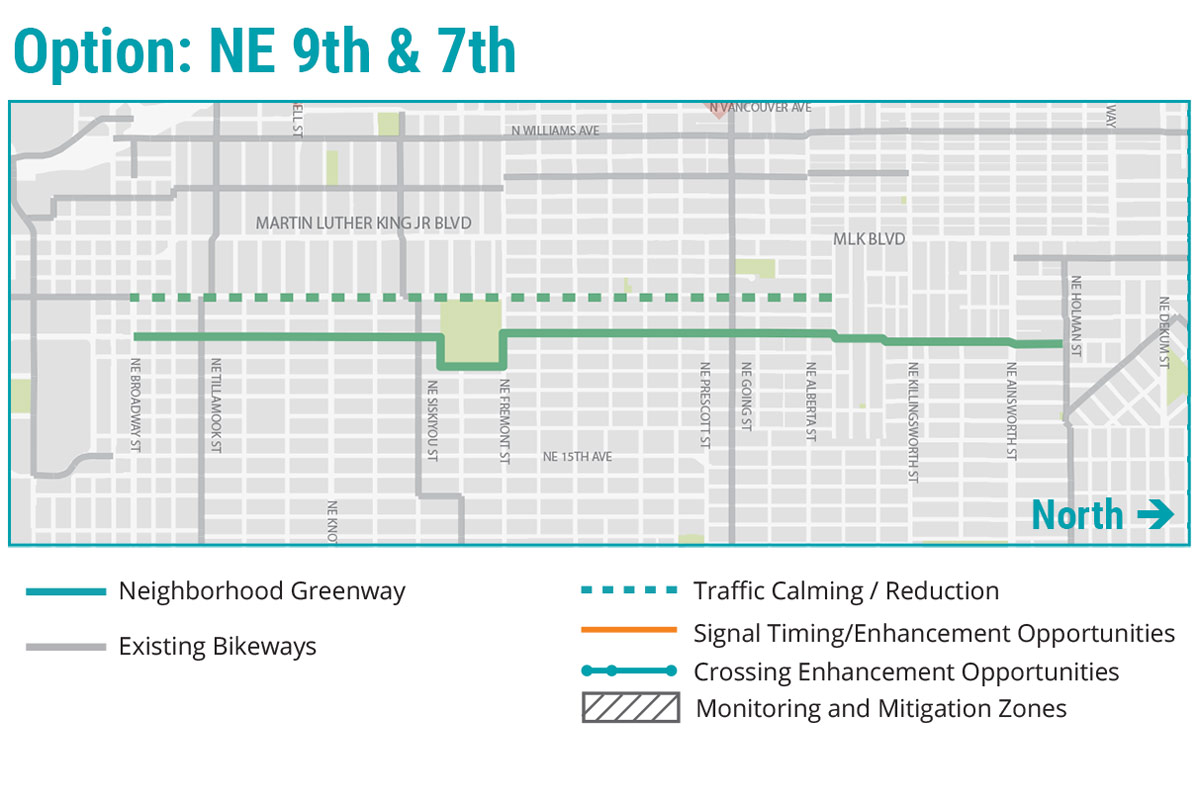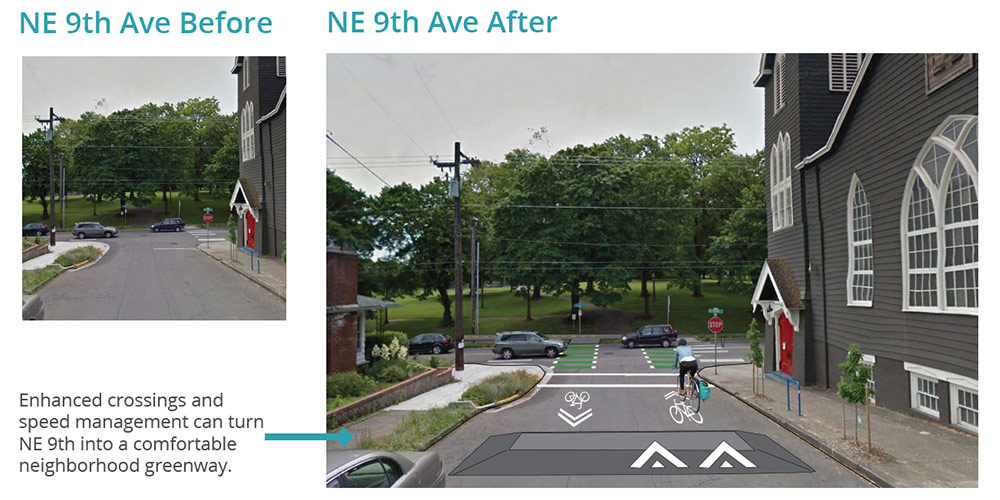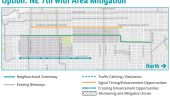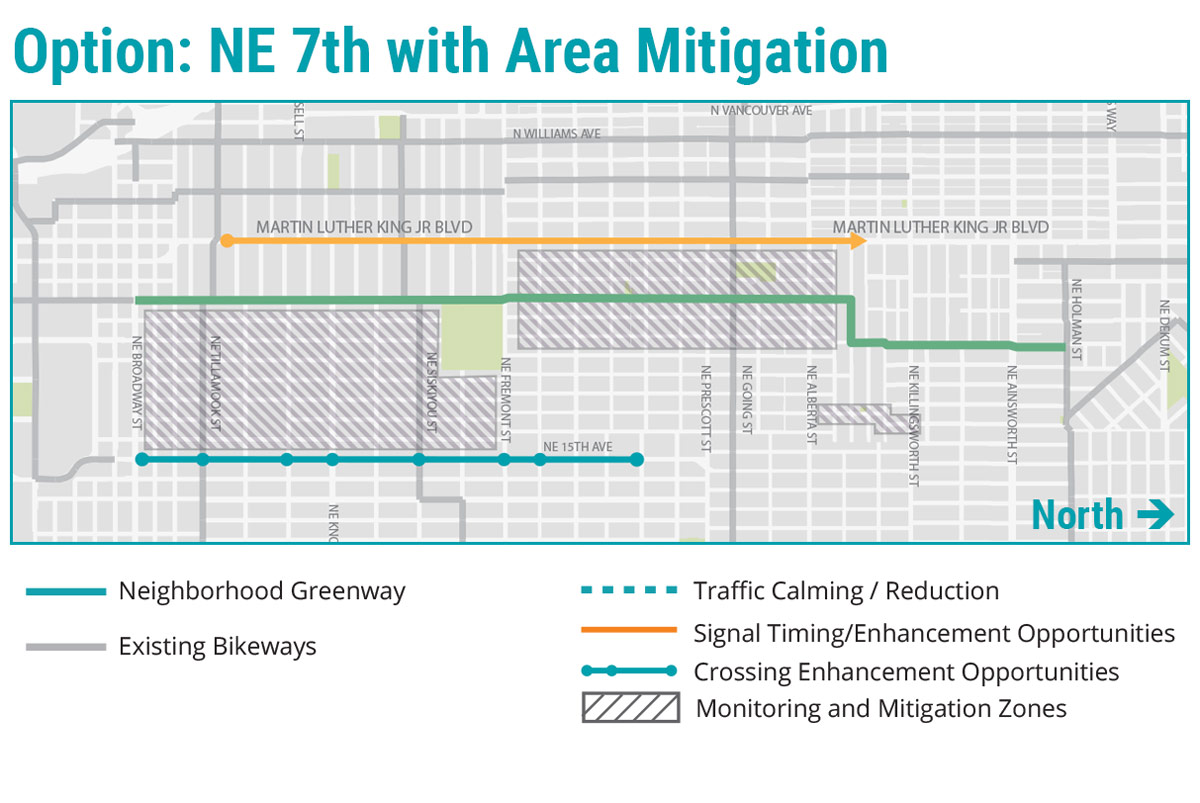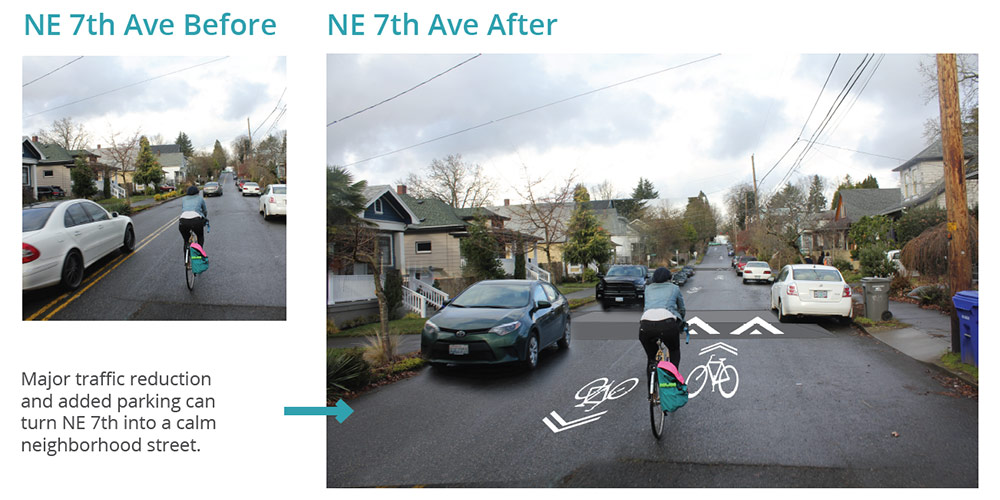Stations
Go directly to a station using the buttons below, or at the top of the screen to move through the stations in order.
= Page includes questions or opportunities for comment.
Project Area
Why are we doing this?
NE 7th and NE 9th Avenues are both identified as bikeways in the Portland Bicycle Plan for 2030. City Council directed the Bureau of Transportation to identify which street should be classified as a Major City Bikeway as part of an update to the citywide Transportation System Plan. This designation is for routes which are direct, connected, and serve high volumes of people biking.
Portland voters passed Fixing Our Streets including a commitment to implement a neighborhood greenway on NE 7th or 9th Avenue. Neighborhood greenways are residential streets that connect schools and parks, while providing access to business and transit.
This project seeks to achieve both of these objectives.
Project Area
The route options have the following characteristics:
- 1.7 miles long
- 4 commercial areas connected
- 5 neighborhoods connected
- 5 parks within ¼ mile
- 6 major street crossings
- 5 bikeway connections
- 4 schools within a five minute walk
- ~17,000 people living in the area between Martin Luther King Jr Blvd & NE 15th Ave.
Benefits of Neighborhood Greenways
- Discourage cut through and speeding traffic in our residential areas
- Help people cross busy streets along the route.
- Increase walking and bicycling activity.
- Offer direct connections to the citywide walking and biking network.
- Support Safe Routes to Schools projects.
- Provide a safe option for people bicycling to destinations along Martin Luther King Jr Blvd.
Greenways Design Elements

Volume Management Tools
Turn restrictions, medians, diverters and other traffic pattern changes can carefully limit the use of a street by cut-through traffic.
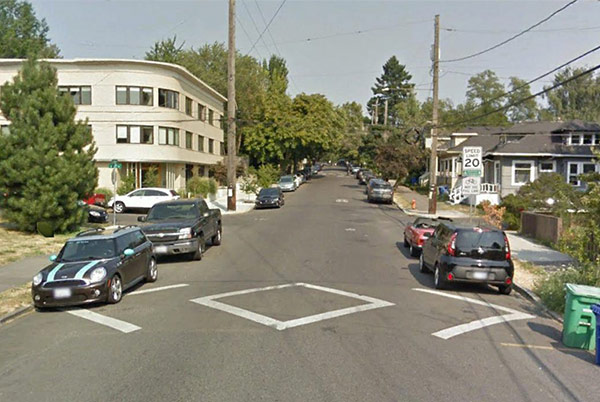
Speed Management Tools
Speed humps, narrowings and shifts in the travel lane are used to lower driver speed.
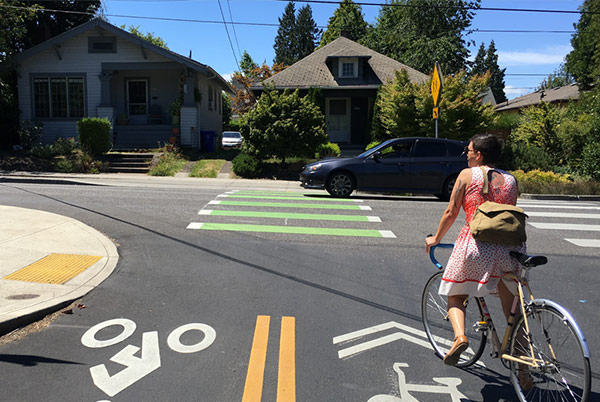
Crossing Tools
Crosswalks, medians and crossing signals allow people using the neighborhood greenway to safely cross the street.
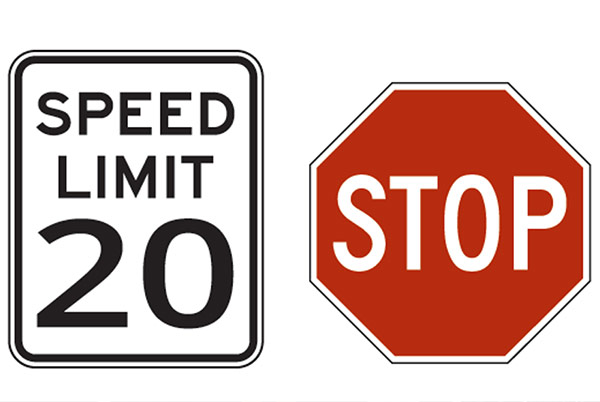
Slower Speed Limits and Stop Signs
Stop signs on side streets favor traffic using the neighborhood greenway. Low speeds provide improved reaction time and safety.
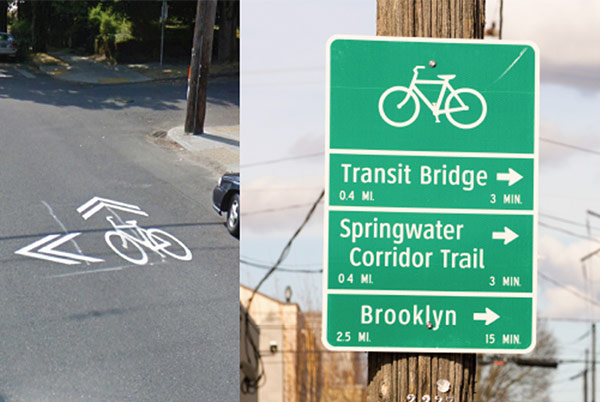
Wayfinding and Markings
Markings and signs Identify the route as a neighborhood greenway, and clearly indicate connections to destinations and other bikeway streets.
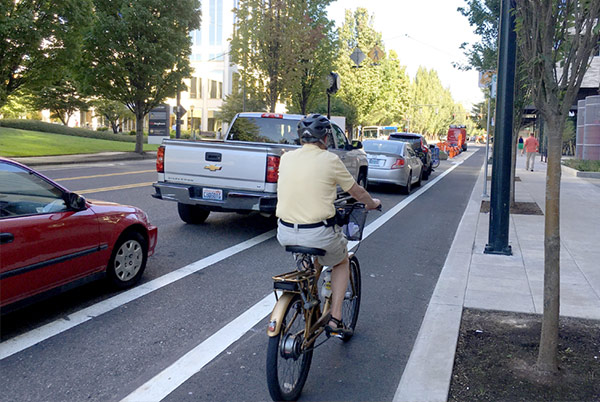
Bike Lanes/Protected Bike Lanes
When traffic cannot be reduced enough to create a comfortable neighborhood greenway, bike lane designs can support comfortable bicyclist travel.
What We Have Heard
Neighbors and community organizations shared preferences, ideas and considerations through public comments and at previous community meetings. Our planning builds upon these comments and considerations.
We've heard the community. Implementing a neighborhood greenway on either street without considering opportunities and impacts on other streets is unacceptable.
Traffic Conditions
Critical characteristics of neighborhood greenways are low traffic speeds and low traffic volumes. Where these conditions don't exist, modifications to the roadway would be necessary to create a comfortable route. (Show graphic.)
Safety
Martin Luther King Jr Blvd is on the citywide high crash network for people walking and biking. Providing a safe option to serve this main street is an important goal of our neighborhood greenway.
Between 2005 and 2014, there were 66 people injured while bicycling or walking along NE Martin Luther King Jr. Blvd. between NE Broadway and NE Ainsworth. This includes one person killed while biking and two people killed while walking.
Areas with many crashes include:
- NE MLK / NE Killingsworth St: 3 people injured while biking, 4 people injured while walking.
- NE MLK / NE Alberta St: 5 people injured while biking, 9 people injured while walking, including one death.
- NE MLK / NE Fremont St: 4 people injured while biking.
- NE 7th Ave / NE Knott: 2 people injured while biking, 1 person injured while walking.
Congestion and Cut-Through Traffic
Data indicates that drivers use NE 7th Ave to avoid evening congestion on Martin Luther King Jr. Blvd. (Show graphic.) This brings excessive traffic levels and high speeds into the neighborhood:
- Most of the traffic is neighborhood traffic. 90% of the traffic starts or ends in the nearby surrounding neighborhoods.
- NE 7th carries a heavy burden. Most local streets carry up to 500 vehicles per day. NE 7th carries 2,000-5,500 vehicles per day.
- NE 7th carries overflow traffic from Martin Luther King Jr Blvd. Near NE Broadway, NE 7th carries about 30% of the traffic volume as Martin Luther King Jr Blvd in the northbound peak hour.
- It is a peak hour problem. Outside of the peak hour, there is capacity on NE Martin Luther King Jr Blvd to carry long-distance NE 7th Ave traffic volumes.
- The problem is more pronounced to the south. Traffic levels on NE 7th are 60% lower near NE Prescott St than near NE Broadway St.
- Trips using NE 7th are shorter than average. According to our traffic model, 60% of all trips using NE 7th are shorter than 4 miles.
Potential NE 9th Enhancements
- Crossing enhancements to improve safety at major street crossings along NE 9th Ave. These enhancements may limit some traffic movements.
- A new bicycle path through Irving Park.
- Speed humps along NE 9th to manage driver speed.
Potential NE 7th Enhancements
- One well placed traffic diverter along NE 7th designed to lower cutthrough traffic volumes
- Volumes would be lower than today, but not enough to meet neighborhood greenway guidelines.
- Speed humps along NE 7th to manage driver speed.
Benefits
- NE 9th is low volume today.
- Irving Park acts as a natural diverter, limiting traffic volumes into the future.
- Proposal provides some cut through traffic relief on NE 7th.
Challenges
- A new path requires careful integration into Irving Park.
- Route is further from destinations.
- Route features less-direct connections to other bikeway streets.
- Does not fully address traffic conditions on NE 7th.
Questions
1. How do you feel about each potential enhancement for a greenway on NE 9th & NE 7th?
2. How do you feel about the NE 9th & NE 7th option overall?
(Check one.)3. What questions, comments or challenges should we consider as we explore the NE 9th & NE 7th option?
characters remaining.
Read other comments...
Potential NE 7th Enhancements
- On-street parking added north of Fremont St.
- Speed humps along NE 7th to manage driver speed.
- Frequent well-placed diverters along NE 7th to dramatically lower cut-through traffic volumes. Access would be designed for residents and businesses.
Potential Area Traffic Mitigation:
- Neighborhood stop sign adjustments to discourage spillover traffic.
- Enhancements to arterial streets, to mitigate for potential traffic increases.
- Monitoring and mitigation of unsafe neighborhood traffic pattern changes.
Benefits
- Addresses neighborhood traffic safety on NE 7th Ave.
- Provides most direct access to the citywide bikeway network.
- Provides closest proximity to destinations.
Challenges
- Re-routes long-distance traffic to arterial streets.
- Careful diverter placement and design necessary to minimize impacts onto other streets.
Questions
4. How do you feel about each potential enhancement for a greenway on NE 7th Plus Area Mitigation?
5. How do you feel about the NE 7th Plus Area Mitigation option overall?
(Check one.)6. What questions, comments or challenges should we consider as we explore the NE 7th Plus Area Mitigation option?
characters remaining.
Read other comments...
Can't see the map? Click here to reload.
How will we decide?
We are considering public feedback from:
- Past testimony and comments
- Information gathered at the February 27 and online open houses
- Future stakeholder discussions about design options and impacts
Many attributes influence the benefits, usefulness and success of a neighborhood greenway. A technical analysis will evaluate our alignments on various technical criteria.
Stay Involved
- Visit the project website at www.portlandoregon.gov/transportation/L2W.
- Sign up for email updates below,
- Contact: Nick Falbo at (503) 823-6152 or nick.falbo@portlandoregon.gov.
Timeline

Final Questions
What is your interest in this project?
(Check all that apply.)How do you travel in the project area today?
(Check all that apply.)Tell Us About You
Participation Demographics (Optional)
The City of Portland complies with all non‐discrimination, Civil Rights laws including Civil Rights Title VI and ADA Title II. To help ensure equal access to City programs, services and activities, the City of Portland will reasonably modify policies/procedures and provide auxiliary aids/services to persons with disabilities. Call 503-823-5185, TTY 503-823-6868 or Oregon Relay Service: 711 with such requests, or visit http://bit.ly/13EWaCg.

